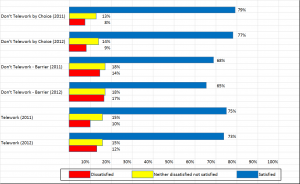Telework – What Happens?
 What happens when employees telework? Since telework has become an important organizational change, not only in the Federal Government but also in the private sector, it’s important for all organizations to envision the success of the effort and measure the results. In a recent report, “Status of Telework in the Federal Government – Report to Congress,” the US office of Personnel Management noted an improvement in employee attitude as a result of telework capabilities.
What happens when employees telework? Since telework has become an important organizational change, not only in the Federal Government but also in the private sector, it’s important for all organizations to envision the success of the effort and measure the results. In a recent report, “Status of Telework in the Federal Government – Report to Congress,” the US office of Personnel Management noted an improvement in employee attitude as a result of telework capabilities.
Measuring the Improvement in Employee Attitude. The Federal Employment Viewpoint Survey (FEVS) shows the potential for telework to influence important employee attitudinal and perceptual variables. The survey looked at employees who telework, those who don’t because of a barrier of some sort, and those who do not telework by choice. Demonstrated in the report is the value of autonomy – “I get to make the decision, to telework or not.” When employees have a choice, job satisfaction increases. Those employees who face barriers to telework reported lower job satisfaction scores. Typically, their attitudes toward the organization and their supervisors are less positive.
Academic research indicates that telework program participants are more likely to exhibit job satisfaction and improved performance. The FEVS survey noted similar findings. There was a larger percentage of teleworkers who reported satisfaction with their jobs than those who were not able to telework. In 2011, those figures were 75% vs 68%, and in 2012 the figures were 73% vs 65%. The survey seems to suggest that existence of telework policies benefits the entire workforce in indirect but positive ways.
In the 2012 FEVS survey, 68% of the respondents reported satisfaction with their jobs. And 15% reported dissatisfaction. The results also show that there is a decline in the percentage of job satisfied employees between 2012 (68% ) and 2011 (71%). This general decline is also reflected in a comparison of teleworker job satisfaction data – reporting 68% job satisfaction in 2011 and 65% in 2012.
Please click on the chart below for more information on job satisfaction.
Tip: Managing Teams
Last month we provided a few tips on successful teleworking. Here are some key tips on Managing Teams.
- Train your team. While you may feel that your employees should know their job, training your employees for working on a team will help build successful teams.
- Keep your team focused. Putting a team together, and then not following up on their progress is asking for trouble. Instead, install a project management system or some type of follow-up plan that allows you to keep the team focused and on task. Your time will be well-spent; your team will be successful.
- Create a timeline. What is your vision? Working with the team, create quarterly touch points. Breaking a project down by quarters makes it easier to reach intermittent goals – assuring success for the overall project.
If you would like more information on Development issues, including Teamwork and Management, please give LMJA Associates a call at 301-670-0051 or email us at Leah@LMJA.com.
Can Strategic Planning Make Your Job Easier?
 Mention Strategic Planning in a meeting and you’re liable to hear lots of groans! For many companies and organizations, strategic planning involves weeks of research, competitive analysis, meetings, budgeting and planning. Besides all that work, strategic planning conjures up the idea that we have to KNOW the future. Or at least take a good guess. Good luck with that. Besides the fear of making the wrong decision, thinking too far in the future just isn’t practical anymore. Thanks to technology and the world we live in, most businesses see so much change that they are revising their strategic plans every 18 months. So, what if you just plan for the year? Make it simple. Here’s how.
Mention Strategic Planning in a meeting and you’re liable to hear lots of groans! For many companies and organizations, strategic planning involves weeks of research, competitive analysis, meetings, budgeting and planning. Besides all that work, strategic planning conjures up the idea that we have to KNOW the future. Or at least take a good guess. Good luck with that. Besides the fear of making the wrong decision, thinking too far in the future just isn’t practical anymore. Thanks to technology and the world we live in, most businesses see so much change that they are revising their strategic plans every 18 months. So, what if you just plan for the year? Make it simple. Here’s how.
First, Analyze. What has worked in the past? What has not worked? Are your employees fully trained? What areas of expertise are lacking? Decide what your strategy is for the year.
Focus on the issues at hand. What are the initiatives in your area that will have the most impact on the organization as a whole? These are the ones you want to focus on. Do your employees have the expertise to carry out the initiatives as planned? Can your area be more productive given more expertise?
Start with the end in mind. Where do you want to be by December 2015? If you know what progress needs to be made, it’s easier to schedule check points throughout the year.
Make a check list. Assuming there are goals for the department and the individual employees, make a list of what needs to be accomplished. Incorporate change management and leadership development training to transform your area to a higher performing organization.
Schedule it. Work it out on paper. What is the initiative? What results are you expecting? And what tools are needed to get there? When you break it down bit by bit, you’ll recognize whether or not your plan is feasible.
Review performance. Meet quarterly, or more often if necessary, to make sure the initiative hasn’t hit a roadblock. Don’t assume that you’ll know when that happens. Too often, organizations learn in September or October that the initiative they thought was humming along, hit a roadblock in June. Now, months have gone by without progress.
Keep it simple. You can tackle a lot, and be disappointed in your results. Or you can take the top issues and get results. Your goal is to get results, so that the next year, you can focus on other issues.
Need some help with starting or updating a strategic plan? Leadership development? Dealing with communication and conflict within teams? We can help. Give Leah M. Joppy & Associates a call at 301-670-0051 or email us at leah@lmja.com – we’d love to help.
Try our tip. Read on for an easy tip to keep you focused on your strategy and get results!
Tip: Divide By Twelve!
 Looking at the entire year and what you hope to accomplish can sometimes be daunting. But what if you broke it down into twelve months? You can stay on track easier, you can see quickly when you are behind schedule, and you can correct problems by adding the right tools to keep you on target. Here’s an example:
Looking at the entire year and what you hope to accomplish can sometimes be daunting. But what if you broke it down into twelve months? You can stay on track easier, you can see quickly when you are behind schedule, and you can correct problems by adding the right tools to keep you on target. Here’s an example:
- Create a spreadsheet with twelve columns. Each column is labeled with a month of the year. We highly recommend using a Work Plan White Board, ‘strategically’ placed in an area within your office so everyone can see their individual progress and how it is aligning with their colleagues progress. Having this information readily available for all to see will head off any potential problems and minimize obstacles.
- The first worksheet is given the name of the first initiative.
- Then think of the year in terms of the initiative. You know where you want to be by December, so break it down. What are the steps you need to take to get to the end result? Schedule these for the appropriate months. You can even list the person who has responsibility for each phase of the initiative.
- Remember to add in reinforcement or follow up – check points on the calendar keep initiatives from slipping. What are the expected results you will see during the year?
Tackling each initiative this way makes it easier to accomplish your plan. You can assign responsibilities. Add reinforcement when necessary. And schedule additional training as needed. Along the way, everyone has a feeling of accomplishment as tasks are finalized and progress is visible.
